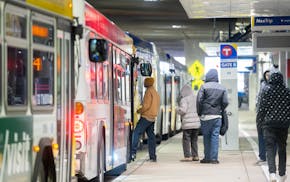That night, everyone counted.
A thousand volunteers fanned out across Minnesota on Thursday, heading to homeless shelters, domestic violence shelters, tent encampments and bus stops — anywhere people might turn for warmth and safety.
It was time for the Minnesota Homeless Study. Every three years, Minnesotans spend one long day finding and talking with thousands of their unsheltered neighbors. The data they gather go to researchers from the Amherst H. Wilder Foundation, who have spent almost three decades trying to figure out not just how many Minnesotans are homeless, but how to get them home.
On Thursday night, the lobby of the Higher Ground shelter in St. Paul was crowded with volunteers and residents, hunched together over 28-page questionnaires. Higher Ground shelters about 500 people a night and is making room for more.
Jeannine Fragola wasn't part of the crowd in the lobby this year. After 11 years on the streets, she was upstairs, in permanent residential housing. She was home.
"I'm grateful that God brought me here," she said, smiling in the room she rents for $279 a month. It's a cozy space, decorated with the red and gold curtains, soft pillows and brocade comforter she found at Family Dollar. The walls are covered with cute kitten and puppy pictures she clipped out of old calendars.
A photograph of her late husband — one she carried and kept safe through all those cold winters on the street — watches over the room. He was a good man, she said. The light of her life. When she lost him in 2006, she couldn't cope. She started drinking. She lost everything, including her home.
Until Higher Ground offered her a place to call home for the rest of her life.
Fragola is 69 years old and terminally ill. But every morning she wakes up in a room of her own that's clean and warm and smells like potpourri.
She has books to read, neighbors for company and a TV lounge down the hall with beautiful views of the State Capitol dome.
"I am so happy," she said. "Being homeless taught me not to take anything for granted."
The study's participants get $10 apiece for their time and help. Researchers get reams of anonymous data about how people became homeless, the dangers and abuse they encounter on the streets, where they turned for help and services, what sort of health problems they face, and painful details like how many times they or their children missed a meal in the past month.
More than 1,200 volunteers worked Thursday night. They visited at least 400 sites and partnered with six tribal governments and hundreds of nonprofits, service providers, homeless advocates and state and local agencies.
It will be spring before Wilder Research publishes the 2018 survey results. Then we'll see how much has changed since 2015, when the volunteers counted 9,312 unsheltered people in Minnesota, and a third of them were children.
But there are some things the staff at Higher Ground and Catholic Charities know even before the numbers come out.
They know that the people they see are getting older and sicker. Elderly men and women settle in for the night in wheelchairs and walkers. The beds in this new multimillion-dollar facility were designed with extra outlets for medical devices, and there's a medical wing for people too ill to be on their own.
Kathy Elliott, 66, stayed in the medical wing for a while, recovering from pneumonia and a knee replacement. By next month, she's hoping to move into permanent residential quarters.
"The first thing I'm going to do when I get a place of my own is cook. I love to cook," she said, looking out the window toward her future home.
She worked in real estate once, she said, buying distressed properties and fixing them up.
"I never thought this would happen to me. But no one ever does, do they?" she said.
She moved to Minnesota to root for the Vikings. That's something else she longs to do — just watch a game again.
Minnesota nonprofits will tell you that the economy may be improving on paper, but it isn't improving the lives of the people they're trying to help. If anything, stagnant wages and sky-high rents in the Twin Cities are sending more people to shelters.
At Higher Ground, there's a dormitory set aside for men who work during the day but can't afford anywhere else to sleep at night.
"I don't plan to stay stuck," said Dyland Allen, 60, just back from a long shift as a dishwasher at a St. Paul restaurant.
He pays $195 a month for the shelter's pay-for-stay accommodations, which come with an assigned bunk and storage, hot suppers, a computer lab, a small library and free laundry facilities. But he dreams of a place of his own, where the nights aren't punctuated by the sound of other men tossing and turning and coughing in their sleep.
Still, he says, "I'm blessed." Between the income from his part-time job and his disability payments, he's saved enough for a down payment and several months' rent. Now he just needs a landlord to take a chance on him.
"I'm a positive individual," he said. "Like Frederick Douglass said: 'No struggle, no progress.' "
jennifer.brooks@startribune.com • 612-673-4008 Follow Jennifer on Twitter: @stribrooks
An Isanti wedding venue closed without warning. Now these couples have 'nowhere to go.'

Brooks: A tale of 124 hoarded Minnesota cats has at least a hundred happy endings

Brooks: The end of the line for Minneapolis' longest-serving bus driver and the start of a new adventure

Brooks: If Uber and Lyft let Minnesota down, maybe Metro Transit will pick us up


